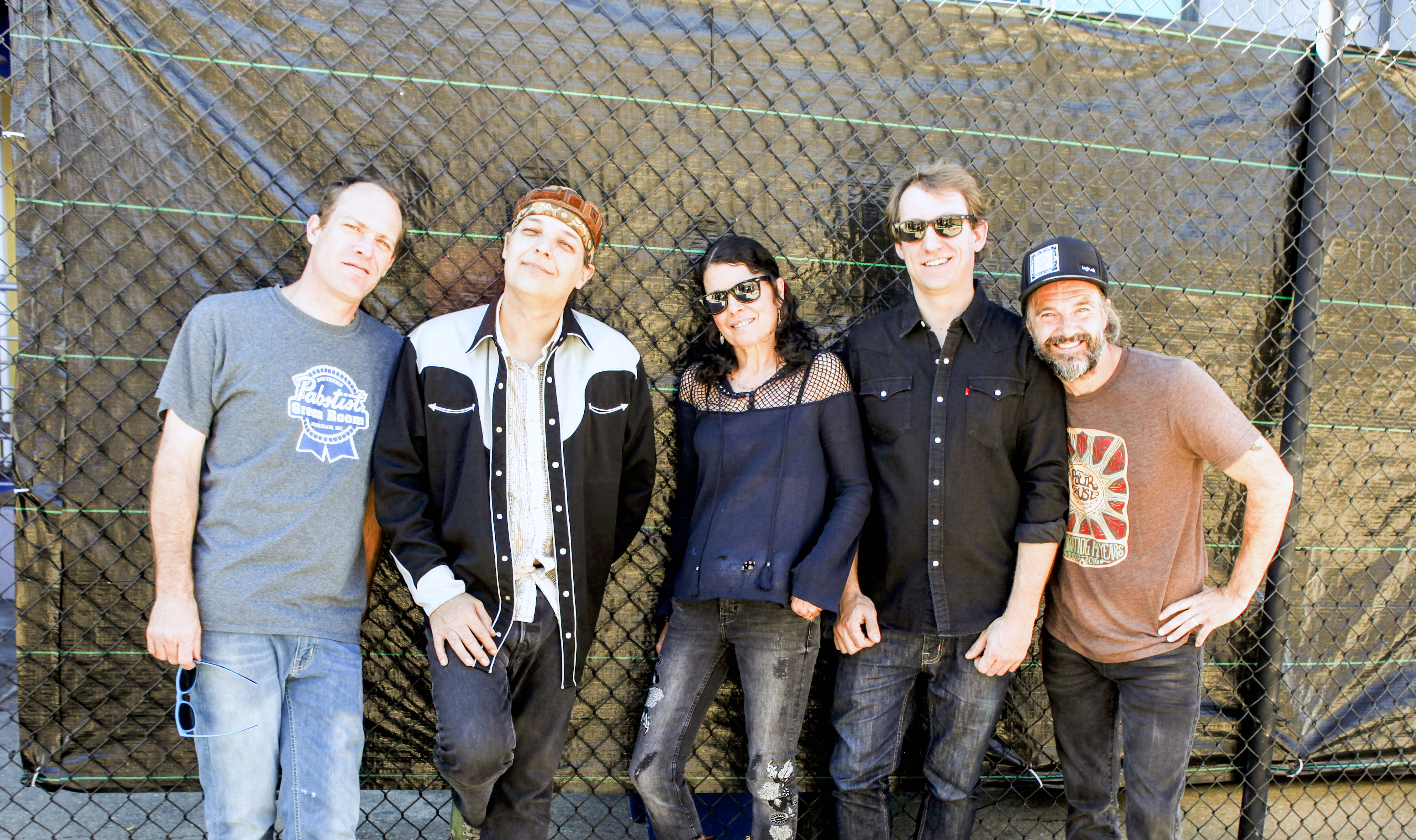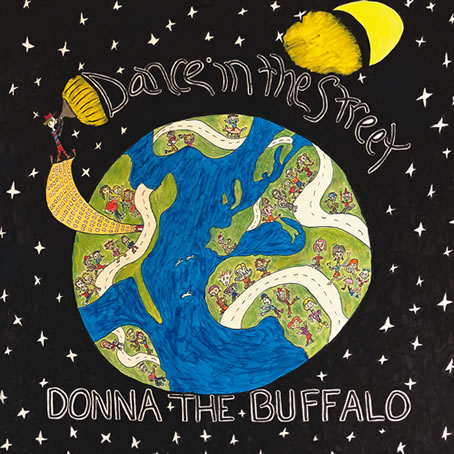Track By Track: Donna the Buffalo ‘Dance in the Street’

photo by Chris Mortenson
Tara Nevins and Jeb Puryear co-founded Donna the Buffalo in 1989, after meeting at an old-time fiddle convention. Over the ensuing years, the group has created music that not only draws on American traditions but also reflects some contemporary themes. As Nevins explains, “We have our little toolbox, but it’s full of history and tradition, mingled in with whatever else we’re singing about that applies to our lives now, as well as these timeless subjects. We live in a complicated world, and our music has some grounded-ness. We have the zydeco influences, we have a fiddle in the band, we have all these different reference points. People sometimes call us a melting-pot band, which overlooks that we’re writing songs, too.”
The Upstate New York-based group, which also features Dave McCracken, Kyle Spark and Mark Raudabaugh, traveled to El Paso, Texas, to record their latest batch of compositions with renowned producer and engineer Rob Fraboni (Bob Dylan, The Band, Joe Cocker). The result, Dance in the Street, is the band’s first release since 2013’s Tonight, Tomorrow and Yesterday.
“We had met Rob Fraboni when we mastered the last record and thought it’d be fun to work with him and develop a relationship,” Puryear explains. “We tried doing a couple different starts with him in various different rooms. He enjoys a looser mic-ing technique. Some of that stuff would sound really good in some of the rooms we chose but, in other ones, we overwhelmed the room because we play loud. Rob had recorded [at Sonic Ranch studio] before and we wanted to make sure that the ambience that leaked into the mics was going to work, so that’s what led us down to El Paso.”
DANCE IN THE STREET
PURYEAR: It’s a response to the current times, encouraging people to voice their opinions, one way or the other. We’re not really in the business of telling people what to think, but we want to encourage people to be as beautiful as they can be as often as possible.
I feel that’s our responsibility. If anybody can think of anything that would make half a difference, they should probably do it now. Having grown up listening to Bob Marley and The Beatles and Bob Dylan, I think that music is a traditional form of reflection for society.
NEVINS: It’s the old saying that music is the universal language. It feels like messages that come across the musical wavelength seep in because music has a melody and there’s so much emotion to that, and when the lyrics go with that, it touches people in a way. It’s a language and it is very universal, so it has the potential to have a certain kind of swaying power or inspirational power.
MOTOR
NEVINS: For me in general, a lot on this record reflects things I’ve been through or where I am. The theme here is letting go, not getting stuck and holding on to something in the past, whether it’s grievances or a relationship or disappointment or resentment—just letting go and moving forward. That’s where the song came from.
HEAVEN & THE EARTH
PURYEAR: The basic idea of this song is that tomorrow is promised to no one. So you better act quick—you might be running out of time—think about what you’re gonna do, think about the past, think about what you wish you did.
There’s a general, loving vibe that emanates through music and, as that permeates, it can do as much good as having a bunch of particular thoughts on various subjects—just knowing that life is cool and it feels good to be here right now, doing this thing. That’s hugely important for people. It’s part of what they need in life and what they’ve developed with us, but it’s also what we’ve developed with each other—being able to play music together and being part of something that’s essentially bigger than any one of us. It’s the most amazing thing to be able to do this.
LOOK BOTH WAYS
NEVINS: “Look Both Ways” is my not-angry-but-I’m-on-to-you kind of song. In relationships, things don’t have to be totally spoken—there’s a lot of understanding that happens between words and without words, and people can be pretty hip to whether they’re being fooled. Like, “You’re a very smart person. You’re on top of all these other things in your environment and I’m just letting you know I’m way ahead of you on this. I’ve got your number.”
I think a lot of people have been in that situation. This song puts it into a verbal form and lets the person know: “There’s a lot of wisdom besides your own going on here.”
ACROSS THE WAY
NEVINS: A friend of ours who we’ve known for many years and who owned a club, used to say that we should have a sign on the back of the stage that read “Donna the Buffalo: We’re changing the world one song at a time.” If you believe in magic, then music can be like magic. So change the world one song at a time through the universal language—the magic of music, the magic of song.
PURYEAR: There’s a bit in there about being able to feel like your ancestors. If you get to a certain place mentally, everything becomes one thing.
TOP SHELF
NEVINS: “Top Shelf” is about how we have expectations and desires that also set us up for downsides, but we should be stoic through it all. Expectations can set us up for disappointment, desires can set us up for frustration, but we should still be grateful and appreciative.
PURYEAR: There’s a point in that song that’s almost like a re-centering. We grew up playing old-time music, and that’s how Tara and I met, and that’s the way I interpret those lyrics. You’re a little lost; you want to get back to the thing that centers and focuses you.
THE GOOD STUFF
PURYEAR: “The Good Stuff” is a portrait of a person going through life, then it says, “Still hurts going to work/ Send the kids off to school/ In a don’t-shoot T-shirt.” It’s a comment on all the shootings, then a comment on faith and, also at the same time, being totally focused on what is actually good about what’s going on in life. It’s all happening simultaneously; it all interacts.

HOLDING ON TO NOTHING
NEVINS: “Holding on to Nothing” is about what it feels like to be in a situation or a relationship where you’re trying to hold on to whatever there is but there’s really nothing you’re holding on to. You’re thinking of it from every single angle until you get to a point where you’re able to break free of holding on to something that’s already gone.
It’s a very difficult situation because part of you knows that, whatever that thing is, it’s gone; it’s over. But then the other part of you isn’t totally sure—“It’s not over ‘til it’s over.” And you’re holding on to that moment where it’s not over ‘til it’s over. That can take a long time and it can be very confusing and trying until you finally, somehow, take a step.
IF YOU WANT TO LIVE
PURYEAR: In lots of situations, I find myself in pain-avoidance mode instead of really living. Somebody once quoted Bruce Lee to me. He said something to the effect of: “If you only look at the stars in the night sky, you miss out on all the heavenly glory.”
In other words, embrace the pain if you want to live. It’s part of life, part of living. So it’s kind of a comment on that. My mom passed away recently, and it’s just coming up against all that stuff where these things are happening. They’re legitimately painful but, at the same time, you should strive to get to a point where you can embrace all that.
I WON’T BE LOOKING BACK
NEVINS: “I Won’t Be Looking Back” is about wishful thinking and how you can base your reality around that even though it’s unrealistic. I wrote the melody and a bunch of the lyrics, but I have two friends, Molly Farr and Bess Greenberg, who helped me finish the song. We’ve done some traveling together and had some really fun life adventures. We were in Nashville one time and we went to Third Man Records where they have this recording booth in the showcase room, and you can go in there and make an old-fashioned record. The three of us went in there and made a happy birthday record for my godson, and named ourselves the Hot Pants Sisters.
When I was writing this song, I knew what it was about, but I was living so deeply in it, I was having a hard time stepping back. So I reached out to my Hot Pants Sisters, and they threw some ideas out and wrote some of the lyrics. It was a really fun co-writing experience with them.
KILLING A MAN
PURYEAR: When the first Gulf War broke out, it was all so sanitized; everything you saw on TV was just the glory and rah, rah, rah part, but they never showed the actual evidence of what took place. I was singing it at this songwriter thing and a Vietnam vet came up to me and was like, “Wow, how’d you get that so right?” So that gave me a little encouragement to go ahead and put it on a record.
The song was also inspired by the movie The Unforgiven, which is gritty and matter-of-fact. They shoot a guy, and he’s crawling around on the sand asking for his mom. There’s a line in the movie: “It’s a hell of a thing, killing a man. You take away all he’s got and all he’s ever gonna have.” Musically, the song goes through the point where they shoot at the guy and there’s a moment where he dies; it’s like the violent part and it has this crescendo where the soul is released. Then, Tara comes in on the fiddle and it’s sort of the ethereal journey of the soul and people mourning; then it comes around with the refrain.
I BELIEVE
NEVINS: Sometimes when I write a song, I’ll write one verse and that says it all to me. Later, I try to write more, and I’m like, “No, I just said it and it feels so complete that anything else I would write would weaken that first verse, take away from the whole message.” That’s what happened with “I Believe.” I wrote those words like a chant, and the chorus just repeats, “I believe, I believe.” We started playing it to audiences, and I kept thinking, “One of these days, I’m gonna have to write the next verse.” But then, I finally realized, “No, I’m never gonna write that next verse” because it already felt complete.
And what started happening at our shows, by the second time around, is that people started singing the chant because it’s easy to grasp the words. The audience was grabbing different lines in the lyrics and singing the words. Then everybody started singing the chorus: “I believe, I believe.” It became really uplifting. It’s everybody’s chant. It’s like, “Yeah, we’re all in this big, crazy mess together, we all hear each other, and we’re all relating here and we’re all believing!”
This article originally appears in the December 2018 issue of Relix. For more features, interviews, album reviews and more, subscribe here.



















